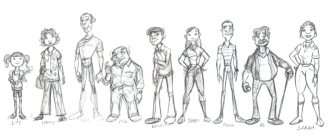Updated July 23, 2022 716 Author: Dmitry Petrov
Hello, dear readers of the KtoNaNovenkogo.ru blog. “This is character!” - we are talking about a person who is tough in his judgments, purposeful in life and unbending under the blows of fate.
As a rule, this remark is pronounced with a degree of envy and admiration. While “spineless” people do not evoke respect from others.
How does the first type of people differ from the second? And is it true that a person can lack character?
What is character
In fact, everyone has character. Translated from ancient Greek, this term literally means “sign”, “ feature ”, “ distinctive mark ”.
If we expand the definition, it turns out that character is a set of stable personality traits, properties of the psyche that determine a person’s behavior, reactions and other manifestations.
For example, in the same situation, people behave differently: a lonely, small kitten will evoke pity in someone and a desire to feed and warm it. Others will remain indifferent to the defenseless creature.
In the first case, a person is endowed with kindness, kindness, and the ability to sympathize with the misfortune of others - these are his distinctive features. In the second case they are absent.
Each person is endowed with his own unique set of characteristic features, so there are no two individuals who are absolutely identical in character. Even individuals who are very similar at first glance will still find differences among themselves.
Social character of personality
Individuals of any society, despite their individual personal characteristics and differences, have common psychological manifestations and properties, and therefore act as ordinary representatives of a given society.
The social character of a person is a general way of adapting a person to the influence of society. It is created by religion, culture, education system and family upbringing. It should also be taken into account that even in a family, a child receives an upbringing that is approved in a given society and corresponds to the culture, which is considered normal, ordinary and natural.
According to E. Fromm, social character means the result of a person’s adaptation to a particular way of organizing society, to the culture in which he is brought up. He believes that none of the known developed societies in the world will allow the individual to fully realize himself. From this it turns out that the individual from birth is in conflict with society. Therefore, we can conclude that the social character of an individual is a kind of mechanism that allows an individual to exist freely and with impunity in any society.
The process of adaptation of an individual in society occurs with a distortion of the character of the individual himself and his personality, to the detriment of it. According to Fromm, social character is a kind of defense, an individual’s response to a situation that causes frustration in the social environment, which does not allow the individual to freely express himself and fully develop, placing him obviously within limits and limitations. In society, a person will not be able to fully develop the inclinations and capabilities inherent in him by nature. As Fromm believed, social character is instilled in the individual and has a stabilizing character. From the moment an individual begins to have a social character, he becomes completely safe for the society in which he lives. Fromm identified several options of this nature.
Human Character Traits
Character traits are a huge list of personal qualities, including kindness, cruelty, compliance, stubbornness, responsibility and irresponsibility, suspiciousness, courage and many others.
They can be either desirable or positive, or negative - which people often want to get rid of (become bolder, more confident).
The entire set of traits is usually divided into 4 large groups , each of which combines certain mental properties:
- Relationships with other people - openness or closedness, kindness or cruelty, arrogance or respect, and others.
- A person’s relationship with himself – self-criticism or arrogance, vanity or modesty, etc.).
- Attitude to work activity – neatness, carelessness, activity – laziness, responsibility – “careless” approach, etc.).
- The attitude towards material things is care or negligence.
All these traits are found in different proportions in different people, thus forming different types of character, which will be described below.
Psychological character of personality
Everyone has long known that significant changes occur in the psychological character of an individual in the process of its development and life activity. Such changes are subject to typical (natural) and atypical (individual) trends.
Typical trends include changes that occur in psychological character as a person grows older. This happens because the older an individual becomes, the faster he gets rid of childish manifestations in character, which distinguish childish behavior from adult behavior. Childhood personality traits include capriciousness, tearfulness, fears, and irresponsibility. Adult traits that come with age include tolerance, life experience, rationality, wisdom, prudence, etc.
As an individual moves along the path of life and gains life experience, changes occur in their views on events, and their attitudes towards them change. Which together also influences the final formation of character. Therefore, there are certain differences between people of different age groups.
For example, people between the ages of approximately 30 and 40 live mainly in the future; they live in ideas and plans. All their thoughts, their activities are aimed at realizing the future. And people who have reached 50 years of age have approached the point where their present life meets simultaneously with their past life and their future. And therefore, their character is modified in such a way as to correspond to the present. This is the age when people completely say goodbye to their dreams, but are not yet ready to be nostalgic for the years they have lived. People who have passed the 60-year mark practically no longer think about the future; they are much more concerned about the present, and they have memories of the past. Also, due to physical ailments, the previously taken pace and rhythm of life is no longer available to them. This leads to the appearance of such character traits as slowness, measuredness, and tranquility.
Atypical, specific tendencies are directly related to events experienced by a person, i.e. conditioned by past life.
As a rule, character traits that are similar to existing ones are consolidated much faster and appear much faster.
You should always remember that character is not an immutable quantity; it is formed throughout a person’s entire life cycle.
Character type
Scientists have not yet come to a consensus about what types of character there are. Various figures have developed their own classifications, the most popular of which are the following:
- E. Kretschmer connected the character and physique of a person . Thus, he got 3 types:
- asthenics or schizothymics are thin people with long arms and legs. Their main features are isolation, low adaptability and seriousness. There is a predisposition to schizophrenia;
- picnics or cyclothymics are short, prone to being overweight, with short limbs and a large head. Sociable and emotional people with developed sensitivity, easily adapt to circumstances. Prone to manic-depressive syndrome.
athletics or ixothimics - have tall stature, good body proportions and developed muscles. They are characterized by authority, desire for leadership, calmness and restraint. Negative character traits include the inability to adapt and show emotions. Prone to epilepsy;
- hyperthymic type – lively, energetic, sociable;
dysthymic - a slow, pessimistic person, withdrawn;
- extrovert - striving outward - sociable, energetic, lives in the world around him;
introvert - seeking inward - closed, lives in his inner world, the external world is not interesting to him.
- the oral type is characterized by dependence on other people’s opinions, immaturity, fear of rejection and the need for support from others;
masochistic – sensual, insightful, loves to suffer;
Manifestation of character
20
PLAN.
I. Introduction.
II. Main part.
1. Definition of character.
2. Features of communication and behavior depending on the types of character accentuation.
3. Manifestation of character in human behavior and activity.
III. Conclusion.
Bibliography.
INTRODUCTION.
Speaking about character, we usually mean those personality traits that leave a certain imprint on all its manifestations and express its specific attitude towards the world and, above all, towards other people. It is in this sense that we usually say that a person has a bad character or a good, noble, etc. We sometimes say in the same sense that such and such a person is characterless, wanting to say that he does not have such an inner core that would determine his behavior; his deeds do not bear the stamp of their creator. In other words, a spineless person is a person lacking inner certainty; Every action he performs depends more on external circumstances than on himself. A man of character
on the contrary, he stands out primarily
by the certainty
of his attitude towards the environment, expressed in the certainty of his actions and actions;
about a person with character, we know that in such and such circumstances he will act in such and such a way. Character determines the definiteness of a person as a subject of activity, who, standing out from the environment, relates to it in a specific way. To know a person’s character is to know those essential traits for him, from which it follows and by which the entire pattern of his actions is determined. Character traits are those essential
properties of a person from which, with a certain logic and internal consistency, one line of behavior, some actions follow, and by which others are excluded as incompatible with them or contrary to them.
1. Definition of character.
Translated from Greek, “character” is “minting”, “sign”. Indeed, character is the special characteristics that a person acquires while living in society. Just as the individuality of a person is manifested in the peculiarities of mental processes (good memory, rich imagination, intelligence, etc.) and in temperamental traits, it also reveals itself in character traits.
Character is a set of stable individual characteristics of a person that develops and manifests itself in activity and communication, determining the individual’s typical modes of behavior.
A person's personality is characterized not only by what he does, but also by how he does it. Acting on the basis of common interests and beliefs shared by everyone, striving for common goals in life, people can discover in their social behavior, in their actions and deeds, different, sometimes opposing individual characteristics. You can, along with other people, experience the same difficulties, fulfill your duties with equal success, love or dislike the same thing, but at the same time be a soft, compliant or tough, intolerant person, cheerful or sad, confident or timid, harmonious or quarrelsome. . Critical remarks of the same meaning addressed to schoolchildren are always made by some teachers in a soft, polite, friendly manner, while by others - rudely and unceremoniously. In people with opposite views on life, with dissimilar interests, with differences in cultural level, with unequal moral principles, these ingrained individual characteristics, as a rule, are even more pronounced .
These individual characteristics that form a person’s character relate primarily to the will (for example, determination or uncertainty, fearfulness) and feelings (for example, cheerfulness or depression), but to a certain extent also to the mind
(e.g. thoughtlessness or thoughtfulness). However, manifestations of character are complex formations and in some cases practically cannot be classified into categories of volitional, emotional or intellectual processes (for example, suspicion, generosity, generosity, rancor, etc.).
Character reveals dependence on social relations that determine the direction of a person’s personality. So, for example, in a society based on the exploitation of man by man, the social position of representatives of the ruling classes contributes to the consolidation in their character of arrogance, conceit, hypocrisy, greed, hypocrisy, etc. A different picture of the determination of character is inherent in a socialist society. Both during the years of peaceful labor and during the Great Patriotic War, the specific character qualities of the Soviet person clearly emerged: dedication, determination, courage, modesty, and hard work acted as the core character traits of people building and defending a socialist society.
The formation of character occurs under conditions of inclusion of the individual in social groups of various levels of development (in a family, a friendly company, a work or educational group, an asocial association, etc.). Depending on how the individual is individualized in his reference group and what is the level of development of interpersonal relationships in it, a teenager, for example, may develop openness, directness, courage, integrity, and strength of character in one case, and secrecy in another case. , deceit, cowardice, conformity, weak character. In a team, as a group of a high level of development, the most favorable opportunities are created for the development and consolidation of the best character traits. This process contributes to the optimal integration of the individual in the team and the further development of the team itself.
Knowing a person’s character, one can predict how he will behave under certain circumstances, and, consequently, direct a person’s behavior. Based on the valuable character traits of the student, the teacher strives to develop and strengthen them, and to weaken the negative ones, or at least compensate them, replacing them with other, socially significant qualities.
2. Features of communication and behavior
depending on the type of character accentuation.
According to the famous German psychiatrist K. Leonhard, in 20 - 56% of people some character traits are so sharpened (accentuated) that under certain circumstances this leads to the same type of conflicts and nervous breakdowns. Accentuation of character is an exaggerated development of certain character traits to the detriment of others, as a result of which interaction with other people deteriorates. The severity of accentuation can vary - from mild, noticeable only to the immediate environment, to extreme variants, when you have to wonder if there is a disease - psychopathy. Psychopathy is a painful deformity of character (while maintaining a person’s intelligence), as a result, relationships with other people are sharply disrupted; psychopaths can even be socially dangerous to others.
But unlike psychopathy, character accentuations do not appear constantly; over the years they can significantly smooth out and approach the norm. Leonhard identifies 12 types of acceptance, each of which predetermines a person’s selective resistance to some life adversities, with increased sensitivity to others, to frequent conflicts of the same type, and to certain nervous breakdowns. In favorable conditions, when it is the weak links of the personality that are not affected, such a person can become extraordinary; for example, accentuation of character according to the so-called exalted type can contribute to the flowering of the talent of an artist, an artist.
Character accentuations are often found in adolescents and young men (50 - 80%). The type of accentuation or its absence can be determined using special psychological tests, for example the Shmishek test. Often you have to deal with accentuated personalities and it is important to know and anticipate the specific features of people’s behavior.
A brief description of behavioral features depending on the type of accentuation is given below.
Hyperthymic (hyperactive) type.
Features of communication and behavior. Excessively high spirits, always cheerful, talkative, very energetic, independent, strives for leadership, risks and adventures, does not respond to comments, ignores punishments, loses the edge of being immature, lacks self-criticism. It is necessary to be cautious about his unfounded optimism and overestimation of his capabilities. Energy is sometimes directed towards drinking alcohol, drugs, and promiscuous sex life.
Traits that are attractive to interlocutors. Energy, thirst for activity, new things, optimism.
Traits that are repulsive and promote conflict. Frivolity, a tendency to immoral acts, a frivolous attitude towards responsibilities, irritability in the circle of close people.
Situations in which conflict is possible. Monotony, loneliness, conditions of strict discipline are contraindicated, constant moralizing can cause anger. There are often cases of manic-depressive psychosis.
Preferred activity. Work related to constant communication: organizational activities, sales service, stort, theater. Tend to change professions and places of work.
Dysthymic type.
Features of communication and behavior. Constantly low mood, sadness, isolation, taciturnity, pessimism, are burdened by noisy society, and do not get along closely with colleagues. They rarely enter into conflicts; more often they are a passive party in them. They value those who are friends with them and are inclined to obey them.
Traits that are attractive to interlocutors. Seriousness, high morality, integrity, justice.
Traits that are repulsive and promote conflict. Passivity, pessimism, sadness, slowness of thinking, “separation from the team.”
Situations in which conflict is possible. Situations that require vigorous activity and a change in the usual lifestyle are contraindicated. Tendency to neurotic depression.
Preferred activity. A job that does not require a wide range of communication.
Cycloid type.
Features of communication and behavior. Sociability changes cyclically (high during periods of elevated mood, and low during periods of depression)
During periods of rising mood, people manifest themselves as people with hyperthymic accentuation, and during periods of declining mood, as people with dysthymic accentuation. During the period of decline, they perceive troubles more acutely, even to the point of committing suicide. There are cases of manic depressive psychosis
Preferred activity. Interests depend on the mood cycle. They are prone to disappointment in the profession and change jobs.
Emotive (emotional) type.
Features of communication and behavior. Excessive sensitivity, vulnerability, deeply experience the slightest troubles, overly sensitive to comments, failures, so they are often in a sad mood. They prefer a narrow circle of friends and relatives who understand perfectly. They rarely enter into conflicts and play a passive role in them. Resentments do not spill out.
Traits that are attractive to interlocutors. Altruism, compassion, compassionate, rejoice in other people's successes. Executives with a high sense of duty. Good family men.
Traits that are repulsive and promote conflict. Extreme sensitivity and tearfulness May provoke attacks from ill-mannered or irritable people.
Situations in which conflict is possible. Conflicts with a loved one, death or illness of relatives are perceived tragically. Injustice, rudeness, and being surrounded by rude people are contraindicated. Prone to neurotic depression, heart attack, hypertension.
Preferred activity. The arts, medicine, raising children, caring for animals and plants.
Demonstrative type.
Features of communication and behavior. There is an expressed desire to be in the center of attention and achieve one’s goals at any cost: tears, fainting, scandals, illnesses, boasting, outfits, unusual hobbies, lies. They easily forget about their unseemly deeds. Behavior depends on the person with whom he is dealing, high adaptability to people.
Traits that are attractive to interlocutors. Courtesy, perseverance, focus, acting talent, the ability to captivate others, originality.
Traits that are repulsive and promote conflict. Selfishness, unbridled actions, deceit, boastfulness, shirking from work, a tendency to “get sick” at the most crucial and difficult moments. Tendency to intrigue, self-confidence and high claims. They provoke conflicts, while actively defending themselves.
Situations in which conflict is possible. Situations of infringement of interests, underestimation of merits, overthrow from the “pedestal” cause hysterical reactions. Tendency to hysteria. A closed circle of communication, monotonous work depress me.
Preferred activity. Favorable to work with constantly changing short-term contacts
Excitable type.
Features of communication and behavior. Increased irritability, lack of restraint, aggressiveness, sullenness, “boringness,” but flattery and helpfulness are possible (as a disguise). Tendency to be rude and use obscene language or remain silent and slow in conversation. They actively and often conflict, do not avoid quarrels with their superiors, are difficult to get along with in teams, and are despotic and cruel in the family.
Traits that are attractive to interlocutors. Outside of fits of anger - conscientiousness, accuracy, love for children.
Traits that are repulsive and promote conflict. Irritability, short temper, inappropriate outbursts of anger and rage with assault, cruelty; weakened control over desire.
Situations in which conflict is possible. Tendency to conflicts over minor issues, neurotic breakdowns, psychopathy, delinquency (immoral behavior, alcohol abuse, antisocial behavior.
Preferred activity. Physical labor, athletic sports. Due to incompatibility, they often change jobs. It is necessary to develop self-control and self-control.
Stuck type.
Features of communication and behavior. “Stuck” on his feelings, thoughts, cannot forget grievances, “settles scores”, intractability at work and at home, a tendency to protracted squabbles, in conflicts they are more often an active party, the circle of enemies and friends is clearly defined. Shows a lust for power - “the boring nature of a moral teacher.”
Traits that are attractive to interlocutors. The desire to achieve high performance in any business, the manifestation of high demands on oneself, a thirst for justice, integrity, strong stable views.
Traits that are repulsive and promote conflict. Touchiness, suspicion, vindictiveness, ambition, arrogance, jealousy, a sense of justice inflated to the point of fanaticism.
Situations in which conflict is possible. Hurt pride, unfair resentment, an obstacle to achieving ambitious goals, a situation of jealousy can cause “delusions of persecution, jealousy.”
Preferred activity. A job that gives you a sense of independence and the opportunity to express yourself. It is necessary to develop flexibility, even forgetfulness.
Pedantic type.
Features of communication and behavior. Pronounced tediousness in the form of “experiencing” details in the service can torture visitors with formal requirements, and exhaust family members with excessive neatness.
Traits that are attractive to interlocutors. Conscientiousness, accuracy, seriousness, reliability in business and feelings, even mood.
Traits that are repulsive and promote conflict. Formalism, “cunning”, “boringness”, the desire to shift important decisions to others.
Situations in which conflict is possible. A situation of personal responsibility for an important matter, underestimation of their merits; tendency to obsession, psychasthenia.
Preferred activity. Professions that are not associated with great responsibility prefer “paper work” and are not inclined to change jobs.
Anxious (psychasthenic) type.
Features of communication and behavior. Low background mood, fears for oneself, loved ones, timidity, self-doubt, extreme indecisiveness, experiences failure for a long time, doubts one’s actions. Rarely enters into conflicts, plays a passive role.
Traits that are attractive to interlocutors. Friendliness, self-criticism, diligence.
Traits that are repulsive and promote conflict. Fearfulness and suspiciousness, due to defenselessness, sometimes serve as a target for jokes, “scapegoats.”
Situations in which conflict is possible. A situation of fear, threats, punishment, ridicule, and unfair accusations are contraindicated. Tendency to psychasthenia.
Preferred activity. You cannot be a leader, make responsible decisions, because... He will endlessly weigh and worry, but will not be able to make a decision.
Exalted (labile) type.
Features of communication and behavior. Very changeable mood, clearly expressed emotions, increased distractibility to external events, talkativeness, falling in love.
Traits that are attractive to interlocutors. Altruism, a sense of compassion, artistic taste, artistic talent, brightness of feelings, attached to friends.
Traits that are repulsive and promote conflict. Excessive impressionability, pathos, alarmism and susceptibility to despair.
Situations in which conflict is possible. Failures and sad events are perceived tragically. Tendency to neurotic depression
Preferred activity. The field of arts, artistic sports. Professions related to closeness to nature.
Introverted (schizoid) type.
Features of communication and behavior. Low sociability, closed, aloof from everyone, communication out of necessity, self-absorbed, doesn’t say anything about himself, doesn’t reveal his experiences, although he is characterized by increased vulnerability. Treats other people with reserved coldness, even close ones. Behavior and logic are often incomprehensible to others. They love loneliness. They rarely enter into conflicts - when trying to invade their inner world. Pickiness in choosing a spouse, search for an ideal. Emotional coldness, weak attachment to loved ones.
Traits that are attractive to interlocutors. Restraint, sedateness, thoughtfulness of actions, strong convictions, adherence to principles.
Traits that are repulsive and promote conflict. Stubbornly defending your unrealistic views. He has his own point of view on everything, often sharply different from the opinion of the majority.
Situations in which conflict is possible. Deprivation of a “hobby” or favorite job is contraindicated. Loneliness, obsession, unceremoniousness, and the rudeness of others increase isolation. Cases of schizophrenia are common.
Preferred activity. Work that does not require a wide range of contacts, interests in theoretical sciences, philosophical reflections, collecting, chess, music, science fiction.
Extroverted (conformal) type.
Features of communication and behavior. Highly sociable, talkative to the point of talkativeness, does not have his own opinion, is not very independent, strives to be like everyone else, disorganized, prefers to obey. He accepts orders from his superiors without hesitation. In society with friends and in the family, he cedes leadership to another.
Traits that are attractive to interlocutors. Willingness to listen to the “confession” of another, diligence
Traits that are repulsive and promote conflict. “A man without a king in his head,” susceptibility to other people’s influence, thoughtlessness of actions, gullibility, passion for entertainment.
Situations in which conflict is possible. A situation of forced loneliness, lack of control and unregulated life are contraindicated. Tendency to hypomania.
Preferred activity. Easy adaptability to a new job. When tasks and rules of behavior are clearly defined, they can be good performers.
3. Manifestations of character in human behavior and activity.
Character
-
the lifetime acquisition of a personality that is included in the system of social relations , in joint activities and communication with other people, and thereby acquiring its individuality.
Leaving an imprint on a person’s appearance, character receives its most vivid expression in his actions, behavior, and activities. Character should be judged primarily on the
basis of people’s actions, which most fully their essence.
There is a well-known Eastern proverb: “Sow an action and you will reap a habit, sow a habit and you will reap a character, sow a character and you will reap a destiny.” The emphasis in it is correctly placed on human actions, which, repeated, become habitual, are fixed in character traits, making up his being, influencing a person’s position in public life and the attitude of other people towards him. System of habitual actions and actions
-
the foundation of a person’s character.
Man by his very essence is active. The structure of human activity includes both various involuntary, automated movements (facial expressions, pantomime, gait, etc.) and intentional actions of greater or lesser complexity. Movements and actions, the implementation of which, under certain conditions, becomes a need for a person, as is known, are called habits.
The most successful portrait does not provide as much information about a person’s character as his usual actions and movements.
And yet, decisive, objective and irrefutable data about a person’s character are provided not by these involuntary actions and movements of a person and not by the features of his external appearance, but by his conscious and intentional actions and actions. It is by actions that we judge what a person is.
Thus, character has a social nature, that is, it depends on a person’s worldview, the content and nature of his activities, on the community in which he lives and acts, on active interaction with other people.
Character is only one aspect of personality, but not the whole personality. A person placed in an extreme situation or simply in a situation
of choice is able to rise above the circumstances, including above his own character.
This ability of a person to withstand any circumstances, including internal, psychological ones, represents a powerful force for a person’s self-change, the basis of his development as an individual. Therefore, any attempts at a final explanation of a person, a forecast of his behavior cannot be final in principle, since a person is capable of devaluing these explanations, challenging them and becoming different, that is, making a choice in favor of his social and universal use (and thereby his own development), and not just compliance with external and internal circumstances.
To the extent that a person is capable of this, what comes to
the fore is not the specific characterological, but the social and universal human . And to the extent that she is not capable of this, the personality really exhausted by its character, typical individual characters and strategies in typical situations.
In addition, the same circumstances are reflected by people far from the same. “Those who want to do things look for means; those who don’t want to do things look for reasons.” Which of the circumstances a person will highlight for himself as significant can be determined both by the external circumstances themselves (at the situational level of behavior), and - further - by the existing individual characteristics of the person (including his character), i.e. internal circumstances, and , finally, awareness of oneself as a subject of action, embodying high social and universal ideals, separated from both external (situational) and internal (individual psychological) circumstances and able to influence them.
Manifesting itself in actions and deeds, to the extent to which the subject is actively involved in joint activities, character turns out to be dependent both on the content of the activity, and on the successful or unsuccessful overcoming of difficulties, on distant and immediate prospects in achieving basic life goals.
Moreover, character depends on how a person relates (based on his previously established characteristics) to his failures and successes, to public opinion and a number of other circumstances. Thus, people studying in the same class of school or working in the same position acquire different character traits in connection with whether they cope with the task. Some people are inspired by success and motivate them to work or study even better, others tend to “rest on their laurels”; Failure depresses some, while it awakens fighting spirit in others.
Thus, the most important point in the formation of character is how a person relates to the environment and to himself - as to another. These relationships are at the same time the basis for the classification of the most important character traits.
A person’s character is manifested, firstly, in how he treats other people: family and friends, work and study comrades. Stable and unstable attachment, integrity and unprincipledness, sociability and isolation, truthfulness and deceit, tactfulness and rudeness reveal a person’s relationship with other people. The character of a person cannot be revealed and understood outside the team. In a team, during live communication with other people, character traits such as breadth or pettiness, quarrelsomeness or complaisance, peacefulness or a tendency to argue clearly appear.
Secondly, a person’s attitude towards himself is indicative of his character: pride and self-esteem or humiliation and lack of self-confidence. For some people, selfishness and egocentrism come to the fore (placing oneself at the center of all events), for others - the subordination of their own interests to the interests of the team, selflessness in the fight for a common cause.
Thirdly, character is revealed in a person's attitude to business. Thus, the most valuable character traits of a person include conscientiousness and diligence, seriousness, enthusiasm, responsibility for the assigned work and concern for its results.
Fourthly, character is manifested in a person’s attitude towards things: not only the attitude towards public property, but also the careful or careless handling of one’s belongings, clothes and shoes, books and teaching aids, etc.
A person’s activity, his behavior, are, first of all, determined by the goals that he sets for himself, and the main determinant of his behavior and activity always remains the direction of his personality - the totality of his interests, ideals and beliefs. However, two people who have much in common in personality orientation and whose goals coincide can differ significantly in the methods they use to achieve these goals. Behind these differences lie personality traits. A person’s character seems to have a program for his typical behavior in typical circumstances. Character traits, therefore, have a certain driving, motivating force, which manifests itself to the greatest extent in stressful situations, when it is necessary to make a choice of actions, and to overcome significant difficulties.
A person who is decisive by nature moves from impulses to actions, often without any long-term struggle of motives. Tactfulness as a character trait of an individual promotes caution in statements, which involves taking into account a number of circumstances and problems that are significant for the people with whom he communicates.
achievement motivation can be considered as a character trait.
- his need to necessarily achieve success in any activity, no matter what he is doing, especially in conditions of competition with other people. Achievement motivation as a personality trait is formed during life as a result of systematic and personally significant rewards for successes and punishments for failures.
CONCLUSION.
Human character is a system of generalized generalized motivations fixed in an individual. The motivations generated by the circumstances of life are the “building material” from which character is formed. An impulse, a motive, is a property of character in its genesis. In order for a motive (motivation) to become a property of a personality, “stereotyped” in it, it must be generalized in relation to the situation in which it originally appeared, spreading to all situations similar to the first, in features that are significant in relation to the personality. A character property is, ultimately, a tendency, an impulse, a motive that naturally appears in a given person under homogeneous conditions.
This understanding of character, connecting it with motives, seems to come into conflict with everyday observations, which indicate that sometimes people of great breath, living with the highest noblest motives, have a difficult character, which makes them not very pleasant companions in everyday communication, and on the other hand, you can often meet a person about whom everyone around him says: “What a good, easy character he has!”, And in this person you will not find either high goals or truly great spiritual motivations. Explanations for this must be sought not only in the fact that in people of the first and second types the center of mental attention is directed to different things, but also in the following circumstance: just as socially developed operations or methods of action are incorporated into abilities, socially developed operations or methods of action are, as it were, inlaid into character. developed modes of behavior that meet the requirements imposed by society on its members. These modes of behavior, which do not directly express the corresponding personal motives of a person, are mastered by him due to motives or considerations of a different order. There is therefore no direct coincidence or correspondence between the ways of behavior and the motives of a person, which are the results of his behavior. As a result, there is, or may be, a discrepancy between a person’s impulses, which are the results of his behavior, and the impulses, ready-made modes of behavior that he has mastered for incoming reasons. The character of a person thus consists of an alloy of impulses and modes of behavior not directly generated by them, acquired by the person. The basis of character is formed not by the modes of behavior themselves, but by the generalized impulses that regulate the corresponding modes of behavior, which, due to their generality, can be abstracted from individual particular situations and become fixed in a person, in the individual. Above the impulses, patterns of behavior mastered by a person are also built into character. Anyone who does not see their basis behind them and judges people only by their “manners” judges them superficially.
The study of character and its formation, still little advanced, should have focused primarily on this problem - the problem of the transition of situationally, by a combination of circumstances, generated motives (drives) into stable personal drives. In pedagogical terms, this determines the main line of educational work on character formation. The starting point here is the selection and instillation of appropriate motives through their generalization and stereotyping, turning into habits.
BIBLIOGRAPHY.
1. General psychology: Textbook. For students of pedagogy. Institute / Ed. A. V. Petrovsky. - M.: Education, 1986.
2. Rubinstein S. L. Fundamentals of General Psychology. - St. Petersburg: ZAO Publishing House “Peter”, 1999.
3. Stolyarenko L. D. Fundamentals of psychology. - Rostov-on-Don: Phoenix Publishing House, 1997.
Formation of human character
Character begins to form from the first days after birth. By the age of 4-5, the general structure of the personality is already visible, and by the age of 10, the character is already fully “complete.”
What factors will influence character traits:
- genetic predisposition - there is an opinion that some traits are inherited from our parents;
- society - parents and other significant adults (relatives, neighbors, teachers), friends, classmates;
- life circumstances are situations that a child faces. For example, the financial situation of the family, events of various modalities also influence the future character. If the same child experiences the death of a loved one or, conversely, something bright and positive, these two factors will leave different imprints on his personality.
Initially, the baby looks at how his parents treat him. Further, it is with this attitude that he will go into the big world. That is, if he was loved , surrounded with warmth and care, talked about his value, then this is exactly how he will feel among others - significant, important, valuable. This is how he will treat people. And vice versa.
Personality traits
The main feature of character in the personality structure is its certainty. But this does not mean dominance of one trait. Several traits, contradicting or not contradicting each other, can dominate a character. Character can lose its definition in the absence of clearly defined traits. The system of moral values and beliefs of an individual is also a leading and determining factor in the formation of character traits. They establish the long-term direction of individual behavior.
The character traits of an individual are inextricably linked with his stable and deep interests. The lack of integrity, self-sufficiency and independence of the individual is closely related to the instability and superficiality of the individual’s interests. And, conversely, a person’s integrity and purposefulness and perseverance directly depend on the content and depth of his interests. However, similarity of interests does not yet imply similarity of characteristic personality traits. For example, among scientists you can meet both cheerful and sad people, both good and evil.
To understand the characteristics of a person’s character, one should also pay attention to his affections and leisure time. This can reveal new facets and characteristics of character. It is also important to pay attention to the compliance of a person’s actions with his established goals, because an individual is characterized not only by actions, but also by how exactly he produces them. The direction of activity and the actions themselves form the dominant spiritual or material needs and interests of the individual. Therefore, character should be understood only as the unity of the image of actions and their direction. It is on the combination of personality traits and his properties that a person’s real achievements depend, and not on the presence of mental capabilities.
What are the types of temperament?
We figured out what character is. These are personal characteristics of a person that are formed from birth. It is often confused with temperament , although these concepts are far from the same thing.
Temperament is a property of the nervous system: its mobility, responsiveness, stability. This quality of an individual is innate and, unlike character, cannot be changed.
Temperament can be thought of as the basis on which character will subsequently be formed, with the former significantly influencing the latter. Hippocrates wrote about the types of temperament; psychology adheres to his classification to this day:
- melancholic – an anxious person who does not cope well with stress due to a mobile nervous system;
- sanguine – balanced, logical, lively, sociable, optimistic;
- choleric – explosive, impulsive, hot-tempered;
- phlegmatic (who is this?) – a stable, hardy personality type, calm and measured.
Temperament and personality
The relationship between character and personality is also determined by the individual’s temperament, abilities and other aspects. And the concepts of temperament and personality form its structure. Character is a set of qualitative properties of an individual that determine his actions, manifested in relation to other people, actions, and things. Whereas temperament is a set of mental properties of an individual that influence his behavioral reactions. The nervous system is responsible for the manifestation of temperament. Character is also inextricably linked with the individual’s psyche, but its traits develop throughout life under the influence of the external environment. And temperament is an innate parameter that cannot be changed, you can only restrain its negative manifestations.
The prerequisite for character is temperament. Temperament and character in the personality structure are closely interrelated with each other, but at the same time they are different from each other.
Temperament embodies mental differences between people. It varies in depth and strength of manifestations of emotions, activity of actions, impressionability and other individual, stable, dynamic characteristics of the psyche.
We can conclude that temperament is the innate foundation and basis on which the personality is formed as a member of society. Therefore, the most stable and permanent personality traits are temperament. It manifests itself equally in any activity, regardless of its focus or content. Remains unchanged in adulthood.
So, temperament is the personal characteristics of an individual, which determine the dynamism of his behavior and mental processes. Those. The concept of temperament characterizes the pace, intensity, duration of mental processes, external behavioral reaction (activity, slowness), but not conviction in views and interests. It also does not determine the value of an individual and does not determine its potential.
There are three important components of temperament that relate to the general mobility (activity) of a person, his emotionality and motor skills. In turn, each of the components has a rather complex structure and is distinguished by various forms of psychological manifestation.
The essence of activity lies in the individual’s desire for self-expression and transformation of the external component of reality. At the same time, the very direction, the quality of implementation of these trends is determined precisely by the characterological characteristics of the individual and not only. The degree of such activity can range from lethargy to the highest manifestation of mobility - constant rise.
The emotional component of a person’s temperament is a set of properties that characterize the characteristics of the course of various feelings and moods. This component is the most complex in its structure compared to the others. Its main characteristics are lability, impressionability and impulsiveness. Emotional lability is the speed with which one emotional state is replaced by another or ceases. Sensibility is understood as the subject’s susceptibility to emotional influences. Impulsivity is the speed with which emotion turns into the motivating reason and force of actions and deeds without first thinking them through and making a conscious decision to carry them out.
The character and temperament of a person are inextricably linked. The dominance of one type of temperament can help determine the character of subjects as a whole.
About accentuation of character
This is an extreme version of the clinical norm, when specific qualities of a person are more pronounced. This gives rise to selective vulnerability to some psychogenic stimuli and influences and amazing resistance to others. This definition seems quite difficult to understand. But it's actually simple. The word itself denotes a strong emphasis on a particular property. That is, some characteristics of an individual are excellently developed, but this causes a certain disadvantage in relation to others. All this leads to personality disharmony. The cause of accentuation may be heredity or the upbringing of a child. The last factor includes:
- excessive care;
- indulgence;
- emotional rejection;
- conditions of the “cult of disease”;
- cruelty or contradiction.
In any case, it is customary to talk about this as a negative phenomenon, since it is associated with problematic properties.
Character Development
Initially, personal properties are formed based on family values, religion and nationality. This is an obvious thing that is no secret to anyone. Another question: what should an adult do, whose characteristics have already been developed, but the manifested traits do not satisfy the internal principles? Start working hard on yourself. First, you should engage in introspection and identify which quality interferes most with your life. This is a pretty important point. For example, a lazy person does not want to engage in self-development, sports, or even work. But if you dig deeper, it may turn out that he is driven by fear of difficulties.
Setting a goal
Willpower helps a lot in the fight against negative characteristics. Everyone has it, you just need to give it the right direction, and for this you need to define a specific intention with a beneficial result. You can choose any business that requires regular effort. It may be a small aspiration. Let's say reading a book. Or more global – learning a foreign language.
Action planning
Now let's make a plan. Remember that you cannot retreat from it. Once you decide to cope with the task, you need to see it through to the end. Set yourself a goal of learning 15 new words a day or reading 3 chapters.
Recording the results
This moment is important because achievements will always loom before your eyes, which will give you an incentive to act further. You can create a table and record your own progress every day. Another interesting method: select any two cities on the map. And when executing the plan, make a point in the direction from one to another. And if you are defeated, return to the point back.
Face-to-face consultation
What are the features and advantages of face-to-face consultation?
Find out more
Skype consultation
What are the features and benefits of Skype consultations?
Find out more
A few words about the characteristic features
These are individual traits that influence life activity, choice of profession and interaction with people. At my consultation, anyone can determine their type and find out how to live with it. In the meantime, I will describe the main points.
Definition and Manifestation
The term character in psychology means a complex of personal qualities. They develop during the period of growing up and manifest themselves in all areas of life, both personal and social. As a result, sustainable human behavior is formed in specific situations. Sounds pretty simple. But in fact it turns out that not all such manifestations can be considered permanent characteristics. A striking example of this is when an individual is in a prolonged state of stress. He is so tense and tired that he can involuntarily become rude or become hot-tempered and unrestrained. But that doesn't mean he's always like this. Only regular expressions of rudeness can indicate such a trait.
Therefore, we add that the “foundation” is laid by nervous activity, or rather, its type, and the dynamics are laid by the environment. There are a huge number of difficult-to-understand explanations of this concept. But if we talk briefly about what a person’s character is, then the definitions will sound like this:
- a set of sustainable behavior that influences the formation of an individual’s type;
- the method of adaptation of the individual to society, the boundary between his internal and external worlds, where he lives;
- a clearly presented system of reactions to stimuli.
One cannot speak of a fully formed character while the individual is growing and developing. The creation of his behavioral characteristics depends on his lifestyle. This means not only the physical sphere, but also the spiritual: thoughts, experiences, feelings. Such a human system is a complex interweaving of social influence and direction. It includes needs, beliefs and worldviews and interests.
About character traits
Most often, behavior develops under the influence of social subgroups, which include the individual. These include family, friendly company, groups at work or study. The development of specific properties depends on which of them is preferred. The position of the individual and the level of his interaction with the group will also play a large role in this. There are several general categories of morality based on attitudes towards certain aspects of the environment.
Features table
| Category | Positive | Negative |
| To other people | With the desire to communicate, qualities such as respect, sociability, openness, kindness, and responsiveness develop. | When there is a need to limit oneself from others, isolation, soullessness, restraint, and contempt appear. |
| To your achievements and activities | Hard work, creativity, dedication, conscientiousness, responsibility, perseverance. | Laziness, irresponsibility, negligence, passivity. |
| To yourself | Such properties as self-esteem, confidence, pride (in a positive way), modesty, and self-criticism come to the fore. | Selfishness, arrogance, excessive touchiness, low self-esteem, arrogance, vanity. |
| To things | Thrift, accuracy, neatness. | Sloppiness, negligence. |
Formation
Character is formed under the influence of family, friends and acquaintances, as well as the team in the service or in educational institutions. The very first influence comes from the family circle - from the parents. This is where the “foundation” for the future development of the child is laid. During life, the mindset and disposition change. Factors also include life circumstances, the creation of a system of values and views, and lifestyle.
Psychologist Daria Milai
Make an appointment
Personality traits are characteristics that determine a person’s behavior in specific situations. Psychologists have identified several classifications. I have already described one of them in the table given earlier. It's time to meet the second one. It is associated with mental manifestations and distinguishes such qualities as:
- Strong-willed – purposefulness, perseverance, independence, activity, self-control, determination.
- Emotional – impetuosity, hot temper, indifference, sensitivity, sensitivity.
- Intellectual - quick-wittedness, ingenuity, interest in everything new, thoughtfulness.










